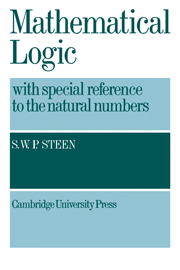Book contents
- Frontmatter
- Contents
- Preface
- Introduction
- Chapter 1 Formal systems
- Chapter 2 Propositional calculi
- Chapter 3 Predicate calculi
- Chapter 4 A complete, decidable arithmetic. The system Aoo
- Chapter 5 Aoo-Definable functions
- Chapter 6 A complete, undecidable arithmetic. The system Ao
- Chapter 7 Ao-Definable functions. Recursive function theory
- Chapter 8 An incomplete undecidable arithmetic. The system A
- Chapter 9 A-Definable sets of lattice points
- Chapter 10 Induction
- Chapter 11 Extensions of the system AI
- Chapter 12 Models
- Epilogue
- Glossary of special symbols
- Note on references
- References
- Index
Chapter 7 - Ao-Definable functions. Recursive function theory
Published online by Cambridge University Press: 07 October 2011
- Frontmatter
- Contents
- Preface
- Introduction
- Chapter 1 Formal systems
- Chapter 2 Propositional calculi
- Chapter 3 Predicate calculi
- Chapter 4 A complete, decidable arithmetic. The system Aoo
- Chapter 5 Aoo-Definable functions
- Chapter 6 A complete, undecidable arithmetic. The system Ao
- Chapter 7 Ao-Definable functions. Recursive function theory
- Chapter 8 An incomplete undecidable arithmetic. The system A
- Chapter 9 A-Definable sets of lattice points
- Chapter 10 Induction
- Chapter 11 Extensions of the system AI
- Chapter 12 Models
- Epilogue
- Glossary of special symbols
- Note on references
- References
- Index
Summary
Turing machines and Church's Thesis
Mathematics is the art of making vague intuitive ideas precise (including the vague intuitive idea of preciseness itself), and of studying the result. We have in Ch. 1 already given a precise definition of language. In this chapter we want to give a precise definition of the vague intuitive idea of calculable function of natural numbers. In Chs. 4 and 6 we gave a precise account of natural number and of primitive recursive function of natural numbers. This will be continued in this and later chapters to give precise accounts of other types of functions of natural numbers.
The vague idea of natural number is made precise by representing them by progressions of tally marks thus:
I II III IIII IIIII
The essential thing is that we have a starting point, here a tally mark standing alone, and a method of proceeding by discrete steps such that we continually generate new formulae, here the method of procedure is to adjoin a tally mark at the right. The arabic notation for the numerals was the first to satisfy these conditions, that is why it is one of the great achievements of the human mind. To make this procedure of adjoining precise we laid down in Ch. 1 that our signs be written on a tape divided into squares. The adjoined tally is placed on the vacant square on the right of the existing sequence (which consists of tally marks on consecutive squares of the tape with a vacant square on the left).
- Type
- Chapter
- Information
- Mathematical Logic with Special Reference to the Natural Numbers , pp. 288 - 386Publisher: Cambridge University PressPrint publication year: 1972

